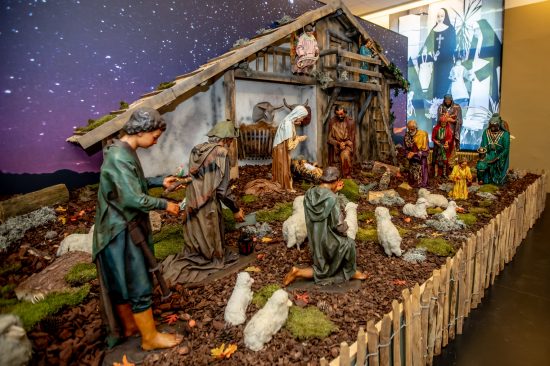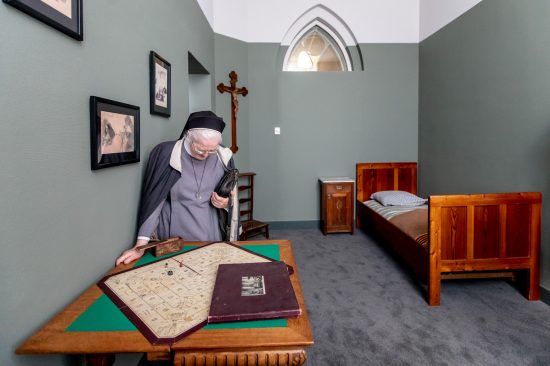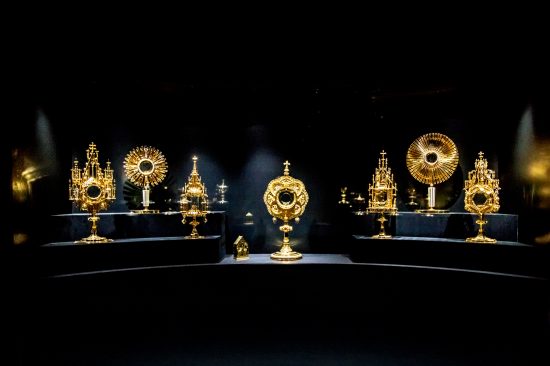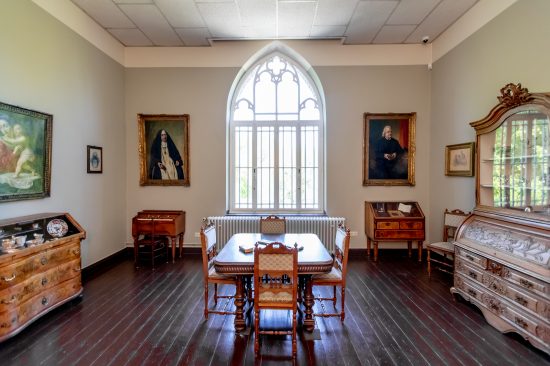
Museum de Schat van Simpelveld
Kloosterstraat 68
Simpelveld
Tel.: + 31-45 2031099
Email: info@deschatvansimpelveld.nl
Postal address:
Stichting Museum Clara Fey
Kloosterstraat 68
6369 AE Simpelveld
RSIN 857374801
Paraments
In the nineteenth century, many convents produced needlework. With the idea that a convent should be self-sufficient, the sisters made clothes for personal use, but also all the vestments that were used in the church: from priest robes to altar cloths.
The Congregation of Sisters of the poor child Jesus also made ecclesiastical textiles, or paraments, but they were distinguished by the high quality and innovative style of their embroidery. For more than a century, the sisters in Simpelveld and elsewhere made the most beautiful paraments. In recent decades they were no longer in use but have been rediscovered as art treasures.
The unprecedented high quality and craftsmanship of the pieces, which have sometimes taken decades of work, make the collection of Museum de Schat van Simpelveld one of the absolute best in the world.


Wax figures
As a token of appreciation, the sisters made small wax figures of the Christ Child, intended for use in the Nativity scene. With the dedication that is so characteristic of everything the sisters did, the wax studio grew and they soon received requests for more figures. The sometimes lifelike wax figures were donated or sold to many countries. The museum has restored a number of groups to their former glory.
In addition, visitors get a glimpse into the creative process of these works of art.
Convent life
Museum de Schat van Simpelveld is located in House Loreto. In its heyday, this convent complex consisted of seven buildings and tens of acres of land. The Hundreds of sisters who lived here, formed an independent community. At the centre was the care for children. There was shelter and education for orphans and poor children.
The sisters also ran a boarding school for daughters of wealthy families. The museum offers you a glimpse into life in House Loreto as it was experienced between 1877 and 2012.


Church treasures
The treasury is the highlight of the visit to Museum de Schat van Simpelveld. It contains the most exceptional and valuable copies of the paraments from the own collection. In addition, there are also highlights from the collection of the more than one hundred establishments that the Congregation had: paintings, golden chalices, monstrances set with diamonds and late medieval sculptures and paintings.
Clara Fey
Of course, the Museum de Schat van Simpelveld commemorates the special woman with whom the history of the congregation and the convent began.
Clara Fey (1815-1894), founder of the Sisters of the Poor Child Jesus, was the daughter of a wealthy cloth manufacturer from Aachen. She saw the impact the Industrial Revolution had on child labour, with most workers under the age of twelve. She perceived it as her vocation to help these children, initially in her native Aachen, but over time the sisters have taken in and taught children in sixteen countries.
Naturally, there is special attention for her beatification, which was celebrated in May 2018, and the life and work of the sisters of the poor child Jesus today.


Kloosterstraat 68
Simpelveld
Tel.: + 31-45 2031099
Email: info@deschatvansimpelveld.nl
Postal address:
Stichting Museum Clara Fey
Kloosterstraat 68
6369 AE Simpelveld
RSIN 857374801